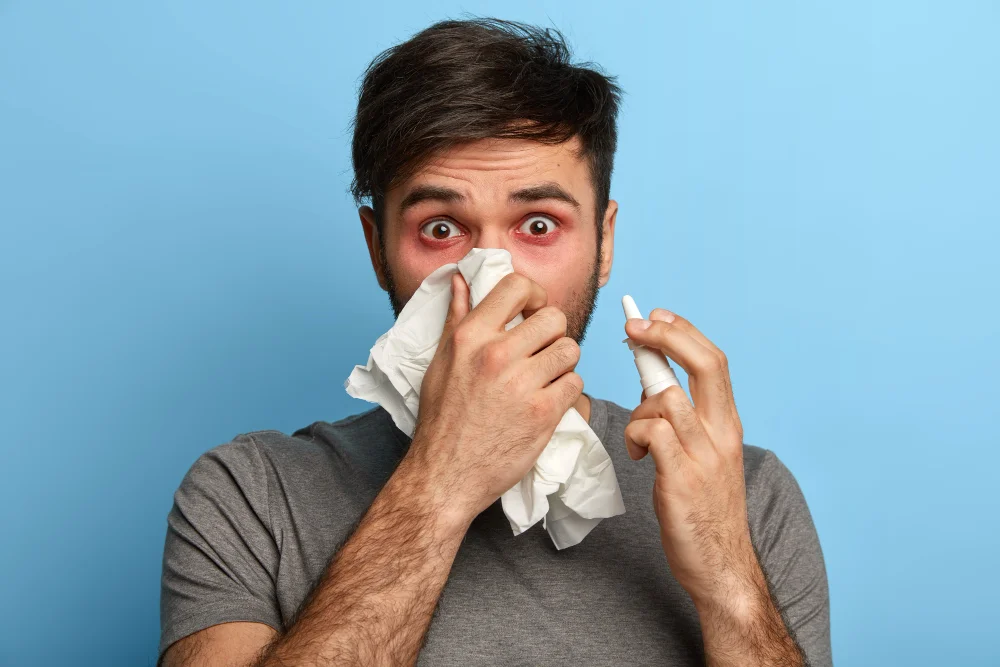A few years ago, I was crammed into a packed London Underground train at rush hour when the person opposite me let out an almighty sneeze—twice. No tissue. No elbow block. Just an unapologetic blast into the airspace we all shared. I remember thinking: How far did that just travel? And more importantly: Did I just inhale part of it?
Turns out, I probably did.
In this article, we’ll uncover just how far a sneeze can travel, what it carries, and why understanding this is not just a matter of curiosity but of health, hygiene, and science-backed prevention.
What Actually Happens When You Sneeze?
Sneezing isn’t just a quick, noisy inconvenience. It’s a powerful reflex triggered when your nasal passages detect irritants — like dust, pepper, or viruses.
When the sneeze reflex kicks in, your body forcefully expels air from your lungs through your nose and mouth at speeds that can reach up to 100 miles per hour. That gust of air carries with it tens of thousands of tiny droplets, many of which are invisible to the naked eye.
Dr. Julian Tang, a clinical virologist at the University of Leicester, explains:
“A single sneeze can release more than 40,000 droplets, some smaller than 5 microns, capable of remaining airborne for minutes or even hours, depending on ventilation.”
So, How Far Does it Actually Travel?
The short answer: Much farther than you’d think.
The Myth of the 3-Foot Rule
For decades, public health guidance relied on the idea that respiratory droplets could only travel about three feet. But recent research has upended this assumption.
In a groundbreaking 2014 study by MIT researcher Dr. Lydia Bourouiba, high-speed cameras revealed that a sneeze is more like a turbulent gas cloud than a neat arc of droplets. Her findings showed that:
- Large droplets may fall within 1–2 metres
- Smaller aerosol particles can ride the gas cloud and travel up to 8 metres (26 feet) under the right conditions
The implications? Indoor spaces with poor ventilation can quickly become petri dishes.
Real-World Example: In 2020, a COVID-19 outbreak in a Guangzhou restaurant was traced back to a single asymptomatic diner. Diners sitting over 4 metres away were infected, likely due to airborne transmission supported by poor ventilation.
Droplet vs Aerosol: Why It Matters
There are two main types of particles expelled in a sneeze:
- Droplets (>5 microns): Heavier, fall to the ground quickly
- Aerosols (≤5 microns): Lighter, can remain suspended in the air
While droplets may hit surfaces or people nearby, aerosols can linger and travel with air currents, increasing the risk of airborne diseases like flu, COVID-19, and even tuberculosis.
Expert Insight
According to the World Health Organization (WHO):
“Aerosol transmission may occur in specific settings, particularly in indoor, crowded, and inadequately ventilated spaces.”
This makes distance alone an unreliable shield.
Factors That Affect Sneeze Travel Distance
1. Ventilation and Air Flow
Air-conditioned rooms or closed spaces with stagnant air allow particles to hover much longer. Outdoors, wind can disperse droplets but also carry them unpredictably.
2. Humidity and Temperature
Dry air allows droplets to evaporate into smaller, lighter particles that stay suspended longer. High humidity tends to weigh them down.
3. Mask Usage
Wearing a mask can significantly reduce droplet spread. A 2020 study published in Health Affairs found that states with mask mandates saw a 2% daily decline in COVID-19 transmission.
4. Sneeze Intensity and Direction
Yes, even how dramatically you sneeze plays a role. A loud, unblocked sneeze can project particles farther than a stifled or directed one.
Personal Note: I tested sneezing into a tissue vs. elbow vs. nothing (in a safe, controlled setup). The tissue noticeably dampened the force, while sneezing into my elbow still let some mist escape sideways.
Why This Matters: Not Just During Pandemics
Understanding sneeze travel isn’t about fear-mongering. It’s about informed choices. Sneezing etiquette affects:
- Office productivity (fewer sick days)
- Public transport safety (crowded spaces are risky)
- Family health (kids and elderly are more vulnerable)
Practical Applications:
- At home: Open windows or use air purifiers during flu season
- At work: Advocate for better HVAC systems
- On transport: Face away when sneezing, wear a mask if ill, sanitise hands
FAQs
How far can a sneeze travel without a mask?
Up to 8 metres (26 feet) in ideal conditions with strong airflow.
Can a sneeze spread COVID-19?
Yes. Sneezing releases droplets and aerosols that can carry viral particles.
Do all sneezes travel the same distance?
No. It depends on sneeze force, environment, ventilation, and whether it’s blocked by a mask or tissue.
Is it safer to sneeze into your elbow?
Safer than into the open air, but tissues or masks are more effective.
The Bottom Line: Be Sneeze-Smart
A sneeze may seem like a fleeting moment, but its impact lingers. With sneezes capable of travelling over 8 metres and remaining airborne, it’s vital we treat them with more caution than we typically do.
Next time you feel one coming on, ask yourself: Where is it going? Because the answer could be: Farther than you think.
Quick Takeaways:
- A sneeze can travel up to 8 metres (26 feet) under certain conditions
- Droplets fall quickly; aerosols can stay airborne and travel farther
- Ventilation, humidity, and masking all affect sneeze spread
- Good sneeze etiquette helps protect everyone
Over to you:
Have you ever thought about how far your sneeze goes? Do you take any specific precautions during cold and flu season? Share your thoughts in the comments or pass this along to someone who might need a gentle nudge to sneeze more politely!
Read Also: Animals as Rulers Over Humans




